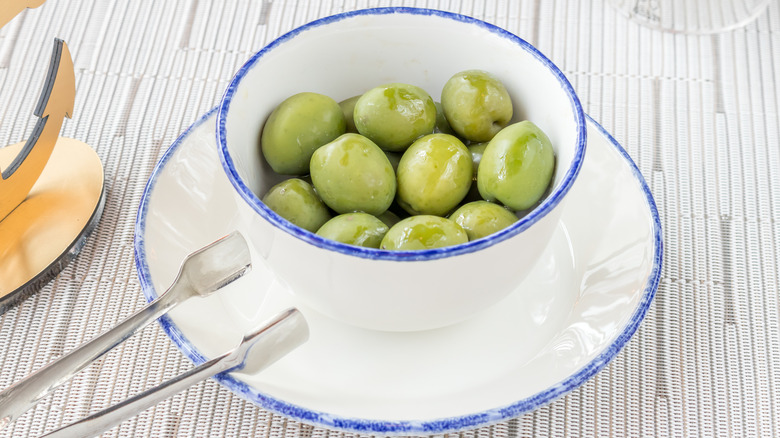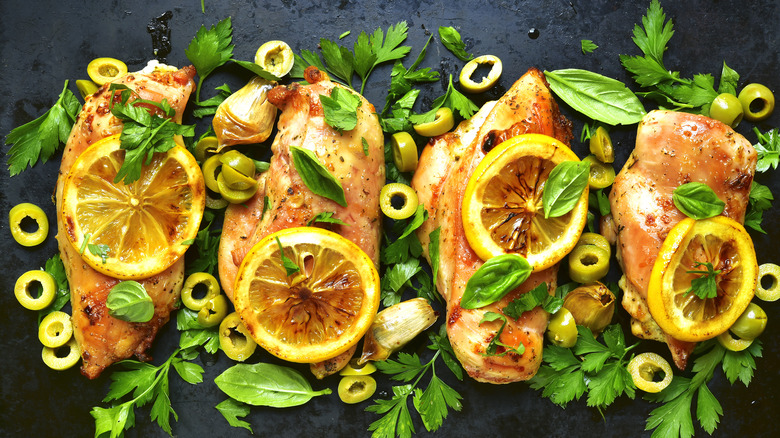Giada De Laurentiis' Favorite Olives Are Criminally Underrated
We may receive a commission on purchases made from links.
Having grown up in her grandfather's Italian specialty market and restaurant, Giada De Laurentiis is not one to have a bare kitchen. The queen of all things Italiano keeps a well-stocked pantry, filled with her favorite ingredients for snacking on — as well as goodies to incorporate into her dishes. Her cookbook, "Giada's Italy," is a personal exploration of her Roman roots and the flavors that inspire her cooking. In it, she shares her list of the foods she keeps around so that she's always ready to whip up something delicious or for an impromptu nosh.
The chef's epic pantry is not a hastily thrown-together affair. Each ingredient has been thoughtfully chosen by someone with a finely tuned palate who knows exactly what to do with them. Examples of this gourmet assemblage include Calabrian chile paste, finocchiona (salami made with fennel), tuna and anchovies, cheeses like Parmigiano-Reggiano, burrata, and mascarpone, speck (a cured ham that's like smoked prosciutto), and staples such as extra-virgin olive oil, balsamic vinegar, jars of roasted red peppers, and polenta. One of the stand-outs on this all-star list is green olives, but not just any kind — De Laurentiis specifies it's got to be Castelvetrano olives.
She describes them as having a "buttery flavor that is more sweet than briny," and she prefers their mild saltiness in many recipes. Castelvetrano olives have quite a following and are known to convert olive haters into lovers with just one taste.
Only one place in the world makes Castelvetrano olives
Castelvetrano olives are known for being rich and creamy, with an initial crispiness that leads to a dense and meaty interior. Their taste is variously described as fruity, delicate, and tangy. Unlike regular olives that go through a fermentation process, Castelvetranos are not fermented; they are cured in water and lye. This method results in a mellow brine level that removes bitterness but maintains the olive's firm bite and unique flavor profile. The olives have a large, round shape and bright green color due to being harvested while still young, keeping them fleshy and crisp. Other olive varieties can tend to be leathery and mushy, especially those harvested when fully mature, like the Kalamata.
Also known as Nocellara del Belice, Castelvetrano olives are grown in the valley of Belice in Sicily. Perfected by an ideal Mediterranean climate, the cultivar is grown for its whole fruits and the manufacture of olive oil. Both have POD trademarks and DOP certifications (Protected Designation of Origin), which means that only olives from Castelvetrano may be designated by that name.
Giada De Laurentiis also singles out Castelvetranos in her wellness book, "Eat Better, Feel Better." The book presents recipes geared toward gut health and immunity, and in it, she identifies the olives as her version of a superfood, in that they taste, smell, and look delicious, but, as she claims, "won't disturb the balance you're trying to restore in your gut."
A jewel among condiments
Castelvetranos are perfect for snacking on right from the jar or served as a crowd-pleasing appetizer. For a cocktail upgrade, you'll love them on a toothpick with their brine flavoring a dirty martini. They're great for cheese and charcuterie boards, pasta, and topped on pizzas, salads, or hummus. They are excellent made into a tapenade spread — or a sauce for meat and fish. They can replace other olives for a twist on tradition — try them instead of Kalamata olives the next time you make puttanesca.
Giada De Laurentiis' favorite olive is featured throughout her recipes, often as a substitute for similarly mild Cerignolas. Her beet, olive, and kale salad gets its kick from orange slices and feta cheese while the olives flesh out the vegetarian dish. Her lamb stew with red wine and olives makes clever use of their light saltiness as well as their appearance — here the olives are used whole and their beautiful bright green color pops like emeralds for an appealing presentation.
Castelvetrano olives team up with capers and figs as an unusual but complimentary marinade in sweet and salty chicken Marbella, a popular Jewish-American holiday recipe. Or, for a super simple brunch dish that can be made or eaten at any time, try a rosemary and olive frittata. Made with both green Castelvetrano and dark-purple Kalamata olives, it comes together in no time but is sure to impress with its olive-forward approach that harmonizes well with the herb-infused fluffy eggs.



